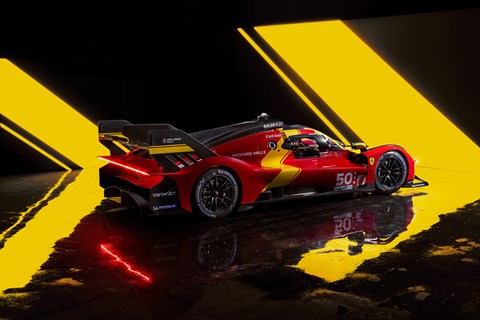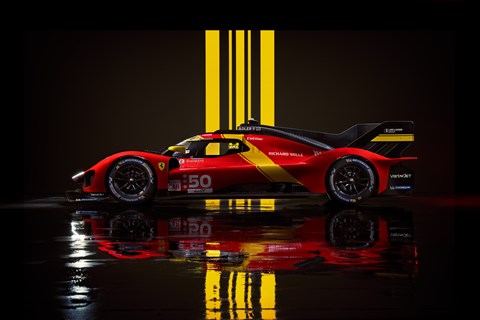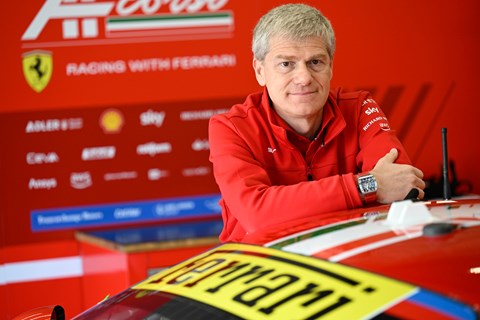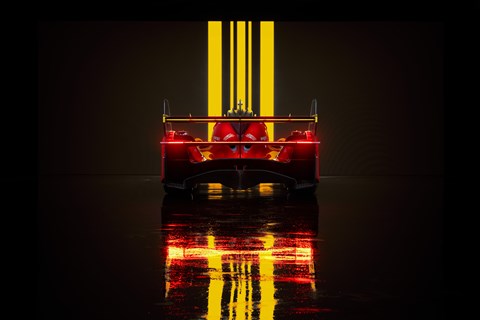► Ferrari 499P: full briefing and official pictures
► Drivers now confirmed, including Antonio Giovinazzi
► First works Ferrari bid for Le Mans victory in 50 years
Ferrari has announced drivers for its 2023 Le Mans return. Its two cars will be piloted by six drivers, including former F1 driver Antonio Giovinazzi and Brit James Calado.
Driving car no.50 will be Italian Antonio Fuoco, Spaniard Miguel Molina and Dane Nicklas Nielsen. Fuoco and Nielsen have a grounding racing and winning in Ferraris, and Molina won the European Le Mans Series in 2021.
Driving car no.51 will be two Italians: Giovinazzi (who raced in F1 between 2017 and 2021, and remains a reserve driver for the Ferrari F1 team) and Alessandro Pier Guidi. Worcestershire-born James Calado has a formidable winning record in the World Endurance Championship racing Ferrari’s 488 GTE together with Pier Guidi.
They’ll be aboard the Ferrari 499P, the LMH prototype racer that marks Maranello’s return to endurance racing’s top table. Two works 499P cars will compete in the top Hypercar category in the 2023 World Endurance Championship, including the Le Mans 24hr race.
The 499P was been revealed to a small group of media at the Imola circuit in October 2022. CAR was up close with the car, and speak to head of Ferrari’s GT sporting activities Antonella Coletta.
The prototype’s dramatic design is shaped partly by aerodynamics and partly by Ferrari’s Centrol Stile design studio, with a red/yellow livery echoing the 312P, its last works Le Mans car in the early 1970s.
What engine powers the Ferrari 499P?
A 3.0-litre twin-turbocharged V6, with its roots in the engine found in the superb 296 GTB and 296 GTS road-going hybrid supercars. It’s not the exact same unit, of course, but the engine’s architecture and twin-turbo ‘hot V’ design is very similar.
‘All the Ferraris, more or less – road cars, F1 – are six cylinders,’ says Coletta. ‘It is our strategy, and for this reason we’ve made this choice.’

The 499P is a hybrid, with a single electric motor driving the front wheels (coupled with a differential and single-speed transmission), and the engine the rear wheels. The V6 feels phenomenal on the road in the 296, in which the hybrid powertrain generates a total of 819bhp. The 499P Le Mans car is capped to 500kW (671bhp) total output, in accordance with regulations.
The front e-axle is able to deploy up to 268bhp to the front wheels when circumstances allow.
A complex brake-by-wire system helps recover energy from the front axle under deceleration, and the friction brakes are specially designed carbon discs.
The engine runs through a seven-speed sequential gearbox at the rear. The double-wishbone, pushrod rear suspension is mounted to the gearbox, and the same layout at the front to the carbonfibre monocoque. The 499P’s minimum weight is 1030kg.
When asked if the 499P’s engineers collaborated with Ferrari’s F1 team on the car’s technology, Coletta replied: ‘We took the battery of F1 – the knowledge of the battery. The rest is totally new.’
A new era of Le Mans racing
Endurance racing’s regulators recently re-wrote the technical rulebook, prompting a swathe of big-name manufacturers to return. That includes brands such as Porsche, and Peugeot, with the latter’s 9X8 Hypercar having already made its race debut. Toyota and boutique manufacturer Glickenhaus are also already racing their own Hypercars in the World Endurance Championship (WEC).
The Hypercar category is divided into two classes: LMH and LMDh. Ferrari (along with Peugeot, Toyota and Glickenhaus) is racing in the former, while Porsche has chosen to join the latter (as have Cadillac and, from 2024, Lamborghini, BMW and Alpine).

The LMH class allows manufacturers technical freedom to design and build every element of their cars, whereas the LMDh class requires entrants to use a ‘spec’ chassis supplied by a third-party manufacturer, and a pre-specified plug-and-play hybrid system (although entrants are allowed to build their own engine and their own bodywork, among other key elements of the car).
LMH is far more costly than LMDh, but allows more technical freedom; LMDh is more affordable but allows less scope for engineering creativity. Balance of Performance regulations, however, will curb the performance of the fastest cars to enable both classes to fight for outright victory. This is a notion that has caused controversy in some quarters.
Why has Ferrari chosen LMH rather than LMDh?
Coletta: ‘Because for Ferrari it’s important to make ALL the car, all the parts. Ferrari is a constructor and for us it’s not our philosophy to buy a part of the car. No, we decided to come back in the prototype class when the rules give us the chance to make all the car.’
That’s not to say Ferrari shouldn’t be worried about the parity the Balance of Performance formula might hand teams and manufacturers in the LMDh category. One wonders what Enzo Ferrari might have made of garagistas competing on a level playing field.
Nevertheless, Ferrari entering in any class other than LMH wouldn’t feel right. As Coletta (pictured below) puts it: ‘This [car] is a manifesto of the technologies of Ferrari. For this, we need to create 100% of the parts of the car.’
Ands while LMH is more costly to compete in than LMDh it’s still a more affordable formula than the old, ferociously expensive LMP1 class, which is one of the factors that has motivated manufacturers to flock back to La Sarthe.

How good a chance does Ferrari stand of winning Le Mans?
Gauging the atmosphere at the 499P’s reveal, it seems appropriate to say that Maranello is hopeful, but realistic.
‘Obviously we would like to win but we know it will be very hard,’ says Coletta. ‘We’ll put all of the knowledge we have on track.’
Ferrari might have been absent from the top class at Le Mans since the 1970s but it’s not as if it’s a newbie to modern-era endurance racing. It’s been one of the top manufacturers in the GTE class, wining the WEC championship, and that class at Le Mans, multiple times.
‘This is our life; we’ve stayed for many years in endurance racing,’ says Coletta. ‘We know that the prototype class is new for us and that probably the first race will be very hard. I hope we will make a difference like in the past in [the] GT [class] where we won without having the maximum power in respect to the others.
‘I think next season will be a difficult season for all. Competitors that have been there for more time will have more chance than the others. In any case, 2024 will be an amazing season, we’re working hard for 202 and we will see.’

Ferrari’s a little up against it, time-wise. Its first test with the 499P happened in July 2022. Toyota, for example, has a big chunk of race experience in the Hypercar class to draw on by the time the two manufacturers face each other on track for real.
‘We need to be consistent,’ says Coletta. ‘I think the reliability will be the most important result we need to have. And after, of course, the speed on the track. But I think we can compete with the other manufacturers – we’ve put all our best in this car.’
Ferrari has committed to a multi-year programme in the World Endurance Championship – although it won’t confirm exactly for how long at present.
How many Ferrari 499Ps will run at Le Mans, and which team will field them?
The AF Corse team, which has fielded Ferrari’s works-backed cars in the GTE class will look after the 499P albeit with a team bolstered with extra Ferrari factory personnel. After 2024, Ferrari will look at selling further cars to independent teams but for 2023 it will concentrate purely on the two factory-backed cars.
The team’s official name will be Ferrari AF Corse.
When is the Ferrari 499P’s first race?
The 1000 miles of Sebring on 17 March 2023.
So far Ferrari has built two 499Ps, which are racking up test miles ahead of the 2023 World Endurance Championship season-opener. The cars have completed more than 6000 miles of testing so far.
Why is the car called the 499P?
A little like Ferrari sports racing cars of the past, P stands for prototype and the number comes from the size of each of the engine’s cylinders in cc.
Closest thing to a Ferrari bid for victory at Le Mans since the 1970s was the 333SP, a sports prototype built in conjunction with Dallara and Momo, and raced by privateer teams in the 1990s and early 2000s. It too was named after its engine’s unitary capacity of 333cc.
Could any of the 499P’s technology influence the next Ferrari road-going hypercar?
Ferrari has confirmed at its 2022 Capital Markets Day that 2023 will bring a road-going hypercar successor to 2014’s LaFerrari. Could the 499P influence its design and technology?
Read our Ferrari reviews
‘I think that for now Ferrari is in a magic moment,’ says Coletta. ‘We have success in all the cars that we realise for the street and for the track. I am sure that this car is a laboratory for more [road car] parts. For now it’s complicated to say that this part or that part will be on a future [road] car but I am sure that in the future we can take some parts or some experience from this programme and put it on the car of the future on the street.
‘Okay, we are coming back [to Le Mans] in the prototype class, the maximum category, but we’ve not forgotten that the race for us is a laboratory for the street car,’ he adds. ‘This link is very important for us.’